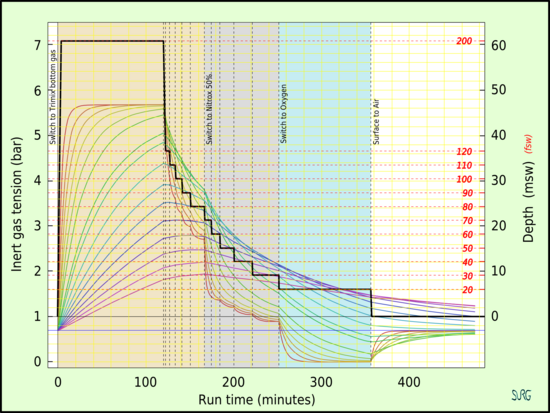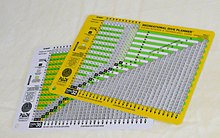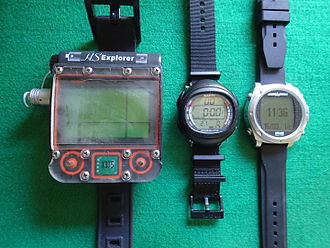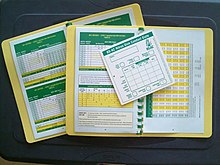Decompression equipment
[5] The choice of tables for professional diving use is generally made by the organisation employing the divers.
[7] Some dive tables also assume physical condition or acceptance of a specific level of risk from the diver.
[7] The Recreational Dive Planner (or RDP) is a set of devices marketed by PADI with which no-stop time underwater can be calculated.
[25][26][27][28] Decompression software can be used to generate tables or schedules matched to a diver's planned dive profile and breathing gas mixtures.
Most dive computers will provide the necessary decompression information for acceptably safe ascent in the event that the no-decompression limits are exceeded.
[33] The personal decompression computer provides a real time modelling of the inert gas load on the diver according to the decompression algorithm programmed into the computer by the manufacturer, with possible personal adjustments for conservatism and altitude set by the user.
In all cases the computer monitors the depth and elapsed time of the dive, and many allow user input specifying the gas mixture.
[32] The computer retains the diver's pressure exposure history, and continuously updates the calculated tissue loads on the surface, so the current tissue loading should always be correct according to the algorithm, though it is possible to provide the computer with misleading input conditions, which can nullify its reliability.
As a result, the diver can make a slower ascent than would be called for by a decompression schedule computed by the identical algorithm, as may suit the circumstances, and will be credited for gas elimination during the slower ascent, and penalised if necessary for additional ingassing for those tissues affected.
This provides the diver with an unprecedented flexibility of dive profile while remaining within the safety envelope of the algorithm in use.
As the parameters move away from the base conditions, conservatism will diverge, and the probability of symptomatic bubble formation will become more unpredictable.
[34] A critical aspect of successful decompression is that the depth and ascent rate of the diver must be monitored and sufficiently accurately controlled.
The shot line float should be sufficiently buoyant to support the weight of all divers that are likely to be using it at the same time.
As divers are seldom weighted to be very negatively buoyant, a positive buoyancy of 50 kg is considered adequate by some authorities for general commercial use.
It allows a commercial diver to travel directly to and from the job site and to control rate of descent and ascent in the same way as using a shotline.
An open-ocean downline is weighted at the bottom, and attached to a substantial float at the surface, which may be tethered to the boat.
In some cases a sea anchor may be used to limit wind drift, particularly if attached to a boat with significant windage.
[44] Also known as a Jersey upline, an upline is a line deployed by the diver, and fixed to the bottom, usually on a wreck, to serve as a position and depth control during offshore ascents in moderate currents, where the diver wants to prevent excessive drift during decompression.
The reel or spool used to store and roll up the line usually has slightly negative buoyancy, so that if released it will hang down and not float away.
[47][48] A delayed or deployable surface marker buoy (DSMB), also known a decompression buoy, is a soft inflatable tube that is attached to a reel or spool line at one end, and is inflated by the diver under water and released to float to the surface, running out the line as it ascends.
This equipment is commonly used by recreational and technical divers, and requires a certain level of skill to operate safely.
Once deployed, it can be used for the same purposes as the standard surface marker and reel, and in the same way, but they are mostly used to signal the boat that the diver has started ascent, as a means of accurately controlling ascent rate and stop depth, or to indicate a problem in technical diving.
A wet bell provides more comfort and control than a stage and allows for longer time in the water.
The sane name is applied to the equipment used to launch and recover small submersibles and ROVs.
[51] Reducing the partial pressure of the inert gas component of the breathing mixture will accelerate decompression as the concentration gradient will be greater for a given depth.
Substitution may introduce counter-diffusion complications, owing to differing rates of diffusion of the inert gases, which can lead to a net gain in total dissolved gas tension in a tissue.
[54] Open circuit scuba divers by definition are independent of surface supply, and must take any gas mixture with them that is to be used on the dive.
[57] Closed circuit rebreathers are usually controlled to provide a fairly constant partial pressure of oxygen during the dive (set point), and may be reset to a richer mix (higher partial pressure of oxygen) for decompression.
[59] Portable or mobile one and two occupant single compartment chambers are not generally intended for routine surface decompression, but may be used in an emergency.
[61] The system can be permanently installed on a ship or ocean platform, but is more commonly capable of being dismantled and moved from one vessel to another by crane.

















